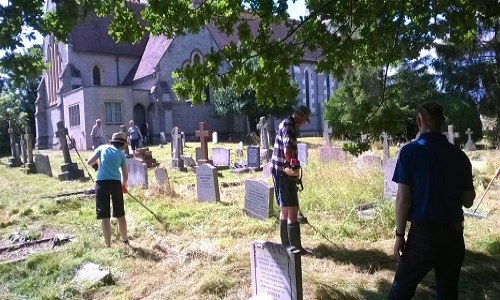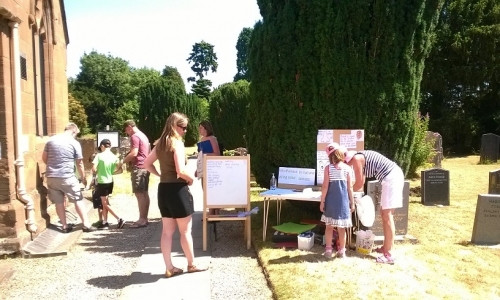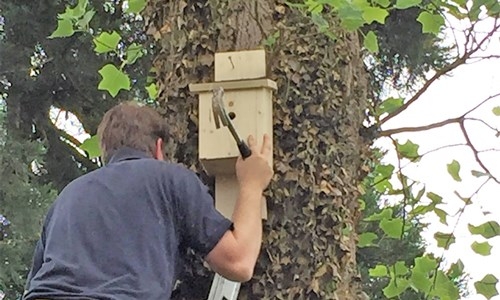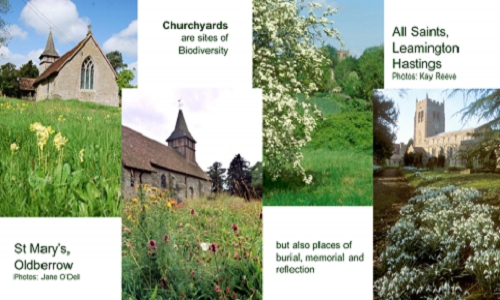| Love your Burial Ground & Churches Count on Nature | |
| Beautiful Burial Ground Week | |
| Resources |
Summer churchyard work party in St James, Alveston

Love your Burial Ground and Churches Count on Nature
For more information about the week which takes place in 2025 from 7th-15th of June - visit https://www.caringforgodsacre.org.uk/churches-count-on-nature-faqs/
Click here for the Action Pack sheet
Churches Count on Nature / Beautiful Burial Ground Week
Visit the website - https://www.caringforgodsacre.org.uk/churches-count-on-nature-faqs/
The CfGA page about iNaturalist and sharing your records is here: https://www.caringforgodsacre.org.uk/about-recording/share-multiple-records/
Find your churchyard
- Church Heritage Record: https://facultyonline.churchofengland.org/churches
- NBN Atlas: https://burialgrounds-places.nbnatlas.org/search?q=
For families and children
- Education pack: https://www.caringforgodsacre.org.uk/resources/education-pack/
- Discovery Pack: https://www.caringforgodsacre.org.uk/resources/burial-ground-discovery-pack/
Wildlife / nature groups
- Ancient Yew Group: https://www.ancient-yew.org/
- Ancient Tree Inventory: https://ati.woodlandtrust.org.uk
- British Lichen Society: https://britishlichensociety.org.uk/
- Butterfly Conservation: https://butterfly-conservation.org/
- A Rocha UK - contact them to ask if there is a volunteer naturalist near you: https://arocha.org.uk/contact-us/
- Wildlife Trusts, again contact and ask if someone can join your count: https://www.wildlifetrusts.org/wildlife-trusts
- Here is the link for training resopurces: https://www.caringforgodsacre.org.uk/resources/films/

Cherishing Churchyards event at St Peter's, Dunchurch 2018

Putting up a nest box in the churchyard at St Andrew's, Eastern Green
The Diocesan Environment Group supports improving biodiversity in churchyards. However, there can be conflict between those who wish to retain the churchyard as a tidy place of memorial and contemplation and those who wish to encourage wildlife. In response to this, the Diocesan Environment Group, in consultation with the Chancellor and Diocesan authorities have produced a Biodiversity Policy Statement which recognises churchyards as first and foremost spiritual places, places of solace and memorials, but which also have a role in enhancing God's creation. View our Diocesan Biodiversity Statement here.
|
|
The Development Phase (Year1) of the £2m Churchyard Biodiversity and Heritage Project has been approved by the National Lottery Fund. The project hopefully will starty in April 2025 The Development Phase will be spent making management plans for up to 80 churchyards in Coventry and Warwickshire, piloting a handful of these to test what works, applying for match funding and preparing the Delivery Phase grant applications for five more years. |
See the National Churches Trust Churchyards Toolkit.
Church of England resources on Biodiversity : http://www.churchofengland.org/more/church-resources/churchcare/advice-and-guidance-church-buildings/biodiversity and from the Churches Count on Nature 2021 week, visit these webinars.
Eco Church resources: A very useful and comprehensive set of booklets on churchyards and biodiversity at https://ecochurch.arocha.org.uk/resources/land/
In many urban areas the churchyard is the only green area in the c ommunity and in rural areas the churchyard can often be the only area of open land that has been untouched by chemical fertilizers or herbicides. Therefore, the variety of plant and animal life in churchyards can be great if they are managed in such a way as to celebrate the diversity of life. Butterflies can be used as a scientific indicator to show how valuable your churchyard is as an environment for wildlife; the Churchyard Butterfly Monitoring document shows you how to do this.
You could set up a Butterfly Garden in part of the churchyard; see https://happydiyhome.com/how-to-start-a-butterfly-garden/ (website reference kindly provided by Jen Miller of Jen Reviews) or https://billyoh.com/resource/grow-butterfly-garden.
Do you have any invasive plants in your churchyard? Check the Plant Alert websiteand report any rogue plants. Send Plant Alert your report of potentially invasive garden plants using the form on the website. You can submit your records from your desktop or smartphone: plantalert.org/app
To cut mowing fuel costs and create a rich haven for wildlife the DEG advises leaving certain designated areas uncut until later in the year, for example until spring bulbs have died down or until summer flowering species such as orchids or cowslips have flowered and set seed: the DEG advises leaving certain areas of the churchyard to be cut, and grass removed, once in the summer and, if needed, once again in October. Details of suggested mowing regimes are given on the Caring for God's Acre website, in the right hand panel. Caring for God’s Acre is a non-religious Charity dedicated to conserving and celebrating burial grounds and encouraging a holistic approach to management. As well as being a place for people, burial grounds can also be a haven for wildlife.
The Centenary Tree Project: in 2018, we celebrated the centenary of the Diocese of Coventry by planting trees in many churchyards and in our Diocesan schools. For details of this, click here.
The Millennium Yew Tree Project: a number of churches in the Diocese received a Yew Tree at a service at Coventry Cathedral in 2000; is yours surviving? Let the Diocesan Environment Officer know at godfrey.armitage@coventry.anglican.org.
Good examples of churchyard management

In the Diocese of Coventry, the churchyard of St Mary’s in Oldberrow is a perfect example of old unimproved neutral grassland. An annual ‘Wildflower Weekend’ is held at the church, as part of our Diocesan Cherishing Churchyards events, to inform visitors of the biodiversity of the churchyard and the churchyard hay cut is often a community event. Seeds from recent hay cuts at Oldberrow have been used to create new areas of biodiverse grassland.
One of the best examples of Churchyard Management is at St James, Alveston, pictured at the top of the page. They have their Spring Working Party at the end of March, a Churchyards weekend in mid-June, a Summer Working Party at the end of July and an Autumn Working Party in mid-November. The management regime balances the traditional use of a churchyard with its place as a site of biodiversity and these events draw in people from the local community to work together and to celebrate. To learn more about this, see http://www.stjamesalveston.co.uk/churchyard.
In autumn 2018, in 2021 and in 2023, Pete Ashton of the Diocesan Environment Group provided bird boxes, free thanks to the Welcome to our Future charitable trust, for putting up in church yards of churches signed up for Eco Church. This amazingly generous offer was extended by Pete to all churches in the Diocese. We should like to thank Pete for all the work he has done for this excellent project.